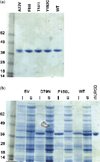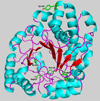Identification and characterization of novel uroporphyrinogen decarboxylase gene mutations in a large series of porphyria cutanea tarda patients and relatives
- PMID: 19419417
- PMCID: PMC3804340
- DOI: 10.1111/j.1399-0004.2009.01153.x
Identification and characterization of novel uroporphyrinogen decarboxylase gene mutations in a large series of porphyria cutanea tarda patients and relatives
Abstract
Porphyria cutanea tarda (PCT) arises from decreased hepatic activity of uroporphyrinogen decarboxylase (UROD). Both genetic and environmental factors interplay in the precipitation of clinically overt PCT, but these factors may vary between different geographic areas. Decreased activity of UROD in erythrocytes was used to identify patients with UROD mutations among a group of 130 Spanish PCT patients. Nineteen patients (14.6%) were found to harbor a mutation in the UROD gene. Eight mutations were novel: M1I, 5del10, A22V, D79N, F84I, Q116X, T141I and Y182C. Five others were previously described: F46L, V134Q, R142Q, P150L and E218G. The new missense mutations and P150L were expressed in Escherichia coli. D79N and P150L resulted in proteins that were localized to inclusion bodies. The other mutations produced recombinant proteins that were purified and showed reduced activity (range: 2.3-73.2% of wild type). These single amino acid changes were predicted to produce complex structural alterations and/or reduced stability of the enzyme. Screening of relatives of the probands showed that 37.5% of mutation carriers demonstrated increased urinary porphyrins. This study emphasizes the role of UROD mutations as a strong risk factor for PCT even in areas where environmental factors (hepatitis C virus) have been shown to be highly associated with the disease.
Conflict of interest statement
The authors state no conflict of interest.
Figures




References
-
- Kappas A, Sassa S, Galbraith RA, Nordmann Y. The porphyrias. In: Scriver CR, Beaudet AL, Sly WS, Valle D, editors. The metabolic and molecular bases of inherited disease. Vol. 2. New York, NY: McGraw-Hill; 1995. pp. 2103–2160.
-
- Kushner JP. The enzymatic defect in porphyria cutanea tarda. N Engl J Med. 1982;306(13):799–800. - PubMed
-
- Elder GH. Porphyria cutanea tarda. Semin Liver Dis. 1998;18(1):67–75. - PubMed
-
- Bulaj ZJ, Phillips JD, Ajioka RS, et al. Hemochromatosis genes and other factors contributing to the pathogenesis of porphyria cutanea tarda. Blood. 2000;95(5):1565–1571. - PubMed
-
- Smith AG. Porphyria caused by chlorinated AH receptor ligands and associated mechanisms of liver injury and cancer. In: Kadish KM, Smith KM, Guilard R, editors. The porphyrin handbook: medical aspects of porphyria. Vol 14. San Diego, CA: Academic Press; 2003. pp. 169–210.
Publication types
MeSH terms
Substances
Grants and funding
LinkOut - more resources
Full Text Sources

